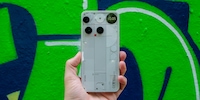
Product test
Review: the Nothing Phone (3) is hot on the heels of top-of-the-range smartphones
by Jan Johannsen

The external display of Motorola’s flip phone is a crowd-puller. But its battery performance and outdated hardware tarnish the overall impression.
External displays on flip phones are getting bigger and bigger. Folding pioneer Samsung only used them as notification screens initially. Three years later, the external display of the Razr 40 Ultra can (almost) be used as a complete smartphone display. The OLED screen measures 3.6 inches.
That’s reason enough to devote a whole chapter to it in this test. It’s definitely the phone’s best feature. Otherwise, the Razr 40 Ultra has to struggle with being equipped with hardware that’s no longer brand new. Beyond the two great displays, the device does a solid job, but falls short of the competition. This is a problem, especially given the price.
Two things caught my eye when I unpacked it. On the one hand, Motorola includes a transparent case. A two-piece version, which makes sense, with a silver stripe on each edge. Chic – and also made of hard plastic, not silicone. This means it doesn’t turn yellow so quickly. Very cool of Motorola.
On the other hand, I had to raise my eyebrows at the power supply with only 30 watts. For a thousand-franc phone, it’s a bit meagre in 2023. There’s also no USB-C port on the power supply.
I think the phone looks and feels great. When folded, the display and the two camera lenses take up the entire front. The light blue back is made of brushed aluminium and is pleasant to the touch. It’s also non-slip. The back is «embellished» with tone-on-tone branding.
The case closes flush: there’s no gap in between and no visible or protruding hinges, which protects your trouser pockets. IP52 certification also ensures that you can use the Razr 40 Ultra in the rain. When folded, the Razr measures just 17 × 7 × 0.7 centimetres and weighs 188 grammes, so you’re not carrying a big lump around with you. Above all, the thin seven-millimetre case feels nice in everyday life.
The unique selling point of the Razr 40 Ultra is undoubtedly the external display with a whopping 3.6-inch diagonal. This may seem small in the age of 7-inch smartphones – but it’s 0.1 inches more than the iPhone 4. In addition, the two camera lenses are integrated into the display, so they take up minimal space. Unfortunately, if you use the phone when it’s unfolded, you’ll leave fingerprints on it. This is unavoidable.
In addition to the size, I like the display itself: an OLED screen with 120 hertz. It shows notifications and the time, but it can also be used to control Bluetooth, Wi-Fi or the cameras. The external display shows what the camera is capturing. Motorola has also provided some entertaining games that were specially developed for the external display.
There are also widgets for Google Calendar, Spotify, the weather app and so on. And you can fully open Android apps. But then the screen starts to struggle. I can retrieve emails or WhatsApp messages and read my fitness app stats, but there’s not room for everything to be displayed. When writing a text, the virtual keyboard takes up all the space, so I can’t tell if I’ve made any typos.
Optimising the apps in terms of size would open up a lot of possibilities, but Motorola’s dependent on support from Google and the respective developers.
It’s a pity that the Razr 40 Ultra doesn’t offer an always-on display. But at least I can set it so that the display is activated as soon as I tap it or move the phone. This is due to the built-in acceleration sensor, which reacts to movement. On the whole, the gesture controls also work perfectly.
You’re limited when it comes to multitasking. You can keep an active app running in a smaller window while launching another. But real multitasking with two apps running at the same time isn’t an option.
Last, but not least, there’s a sidebar that you can also disable. You can fill this with your eight favourite apps. A small swipe from right to left opens it for quick access.
Motorola guarantees software updates for three years – so you’re safe up to Android 16. Security updates will then continue for another year.
The famous «crease», i.e. the fold in the display, is barely visible, but I can still feel it if I run my finger over it. Motorola does no worse a job than Oppo, for example. Compared to last year’s Samsung Flip, it’s a treat. What stresses me out, however, is the fact that the device isn’t completely straight when opened.
Motorola has invested heavily in the technical details of its display. In addition to the resolution detailed above, the Razr 40 supports Ultra HDR10+, 10-bit colour depth and a refresh rate of 165 hertz – even if the latter is a theoretical value. The peak is usually 120 hertz with normal use. The colours are rich, the icons and the displayed screen content are sharp. The Razr 40 Ultra impresses on all levels.
The touch sampling rate indicates the frequency of input recognition. Basically, how quickly the display recognises touches one after the other. These are usually intervals of a few milliseconds. The touch sampling rate doesn’t matter to you when you’re typing. When it comes to gaming, however, it can be important. The average frequency for a modern Android phone between 120 and 300 hertz.
I used the Touch Sample Rate Tester app. During a 30-second measurement phase, I ran my finger up and down the display and the app measured how many times my input was recognised. In my test, the Razr 40 Ultra’s rate was 242 hertz. That’s good. It means that the phone detects and responds to a screen touch 242 times in one second.
I tested the display with a (digital) light meter and it almost reached the 1,400 nits (or lux) promised by Motorola. I measured 1,355 in the test – with manually set and fixed display brightness and a white test screen. I gave the lighting of my test environment and the app a certain tolerance and rounded up. Goal achieved. It’s even 1,369 lux on the small external display.
I can read anything outside anytime. I can even decipher small letters when the sun’s shining directly on the screen.
I find it amazing that Motorola chose a Snapdragon 8+ Gen 1 when choosing the CPU. The Qualcomm processor is only a year old, but it’s already been supplanted in terms of performance by the Snapdragon 8 Gen 2 processor, which is only slightly younger.
What’s particularly interesting is that the Galaxy Z Flip5 from Samsung was launched around six weeks after the Razr 40 Ultra. Motorola knew the South Korean flagship was coming. It was also clear that Samsung would use a Gen 2 processor. For a phone that the manufacturer charges 1,200 francs for, I’d have expected the latest generation of processor. The GPU is the Adreno 730 – and the Adreno 640 GPU, also from Qualcomm, would also have been available.
As you’d expect, both single and multi-core benchmark values trail the older Galaxy S23 Ultra phones by Samsung and Motorola’s own Edge 40 Pro. Both were provided with a Gen 2 processor – but also with more RAM (12 gigabytes instead of 8 in both cases).
The same goes for the GPU value: the Razr 40 Ultra’s score is well below the two flagships equipped with the Adreno 740. In terms of price, the Samsung device is on par, and the Edge 40 Pro is actually significantly cheaper than the Ultra.
You won't notice any major differences in everyday use – the device runs totally smoothly even when gaming. But it remains to be seen whether this will still be the case in two years’ time, or whether the older hardware will mean that certain games will no longer run properly.
But I also have to praise the Razr 40 Ultra. The fingerprint scanner on the side – built into the power button – is not only well positioned; it’s also fast and reliable. The same applies to face recognition. The gap between «showing my face» and using my phone is so short that my reflexes aren’t fast enough to measure the time. So, I’ll just call it fast. Wi-Fi 6E is also not (yet) a given, not even for flagship phones.
With the countless features that a smartphone has today, its core function is often forgotten: making calls. I conducted two test calls – one outside and one inside. Both times, the Razr filtered out any background noise nicely.
Neither the wind outside nor the noise of the dishwasher inside bothered the recipient of my call. I didn’t hear any disruptive background noises on their end either.
Similar to Oppo with the Find N2 Flip, Motorola has opted for a dual setup on the external display. Meanwhile, on the main screen, you’ll find the punch-hole selfie cam, i.e. integrated in the display.
The main camera has 12 megapixels and an f/1.5 aperture. The camera supports pixel binning and has optical image stabilising. The second one, an ultra-wide-angle camera, comes with 13 megapixels, an f/2.2 aperture and autofocus and macro functions.
The selfie cam on the front is a 32-megapixel camera with an aperture of f/2.4 – the same specs as last year, apart from the main camera.
The software offers the usual modes found on every flagship product these days: a portrait mode, a night mode or a pro mode that gives you the option to shoot in RAW. The formats and the ability to use the external display for selfies with the large cameras are more exciting.
There are some limitations. You can’t take 16:9 photos like this because the format of the external display doesn’t match. You can activate a timer and a preview so you can see what the selfie will look like. This gives you a few seconds to fix your hair and it also helps with edge detection.
The camera’s daylight performance is fine, although not outstanding for a phone in this price range. The photos are rich in detail, which I like (left RAW, right JPG).
I also like the vivid colours and low noise. However, I feel that the AI-based post-processing oversharpens the photos a bit.
I’m pleasantly surprised by the ultra-wide angle. Here, too, I like the colour reproduction and the high degree of detail. This camera isn’t state of the art either, but it’s okay.
The sharpness and details are also right in macro shots, even when the lighting conditions aren’t the best. They’re always good enough for holiday snapshots.
Night photos in standard mode (left) show light and shadow – in the proverbial sense. The light sources look good, and the shadow areas are also clear. However, there’s very little artificial brightening, the AI struggles too much with noise reduction for me – the details and sharpness suffer as a result.
The Razr 40 Ultra’s night mode helps with the details, but the pictures aren’t exactly sensational.
Portrait mode gives me shots with beautiful bokeh.
The colours look less sharpened than in normal photo mode. However, the level of detail suffers when the ambient light decreases. The Razr allows different aspect ratios, 4:3 and 16:9. So, you can choose the right one for your needs.
The selfie camera is a phenomenon. On paper, it’s no match for the main camera.
Nevertheless, I still prefer it for taking selfies. I like the photos it takes. They're less over-sharpened and more natural.
Because of the design, the manufacturer can’t squeeze a 5,000 mAh battery cell into a flip phone case. The Razr 40 Ultra comes with 3,800 mAh. Flagship models with a «normal» design and larger batteries last longer.
But Oppo’s Find N2 Flip also comes with a 4,300 mAh battery. I put the Razr 40 Ultra through various tests. As my daily driver phone, it held up well during an average day.
I’m still testing the battery for specific use cases. At 66 per cent screen brightness, the charge level drops by eight per cent after an hour of video streaming, 14 per cent after an hour of active Google Maps use and two per cent after an hour of audio streaming. Compared to other flagship phones, the former in particular is bad, but not fatal.
Less pleasingly, as I feared, the Razr 40 Ultra performs poorly when it comes to charging speed. I only plugged it in after it had switched itself off. So, we’re looking at 0 per cent battery. After a 30-minute charge cycle, I’m only at 47 per cent. The battery takes 1 hour and 29 minutes to charge fully. As Motorola only includes a 30-watt charger, that’s as good as it gets. It’s not competitive.
The Motorola Razr 40 is expensive, but it offers a lot in return. Both screens are great. They’re vivid and bright enough. The external display in particular surprises with its capabilities. The chipset is no longer the newest, but it’s definitely enough for everyday use. The battery life and charging speed are less convincing. The camera’s fine for a flip phone – but if you’re a photo enthusiast, you’d prefer a classic smartphone.
All in all, the Razr 40 Ultra is on par with this year’s flip phones. So, if you attach particular importance to a great feel and a large external display, you could get one without hesitation. But, if you’re patient, I’d wait for the Galaxy Z Flip 5 product test.
Header image: Florian BodokyI've been tinkering with digital networks ever since I found out how to activate both telephone channels on the ISDN card for greater bandwidth. As for the analogue variety, I've been doing that since I learned to talk. Though Winterthur is my adoptive home city, my heart still bleeds red and blue.
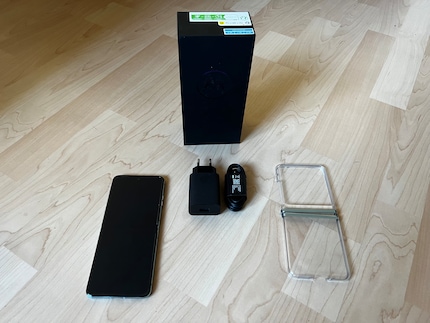
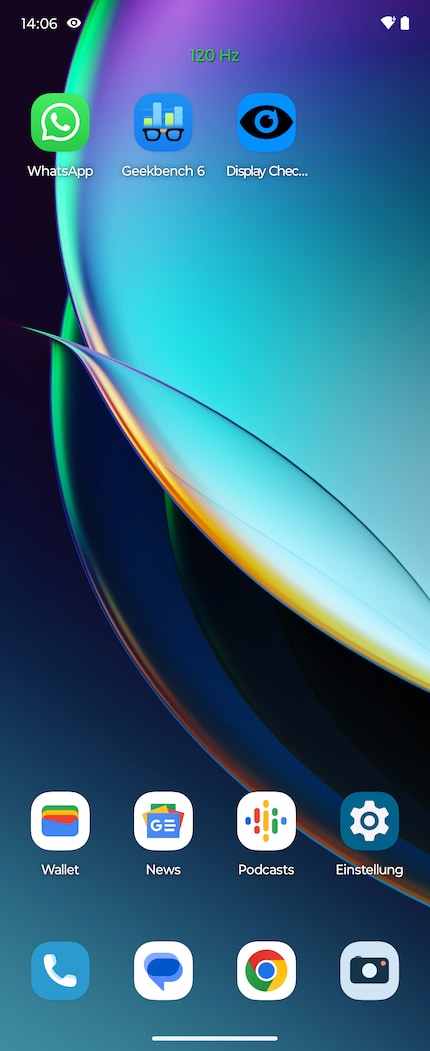
I like an Android that’s as «pure» as possible. Without «OTT» manufacturer-specific additional menus or pre-installed apps. This not only saves memory. Devices with Android One get Android updates earlier because they don’t have to be specially adapted to manufacturer software. There are hardly any pre-installed apps, and the structure and composition of the menus haven’t changed. As this is a foldable smartphone, Motorola has had to make a few adjustments. Android One isn’t yet designed for two screens, and the apps aren’t adapted accordingly. The widget feature has also been customised because of the second screen, but it didn’t bother me that much.
The large internal screen also impressed me in more ways than one. In addition to its 6.9-inch diagonal, the LTPO OLED panel has a resolution of 1080 × 2640 pixels. This corresponds to an aspect ratio of 22:9. The aspect ratio isn’t a common one, but I really liked it in the test because the 6.9-inch display is huge. If the ratio were different, it’d be difficult for me to reach each corner of the screen with my thumb when I have to hold the back of the phone at the same time. Using it one-handed is still a challenge with my small hands.
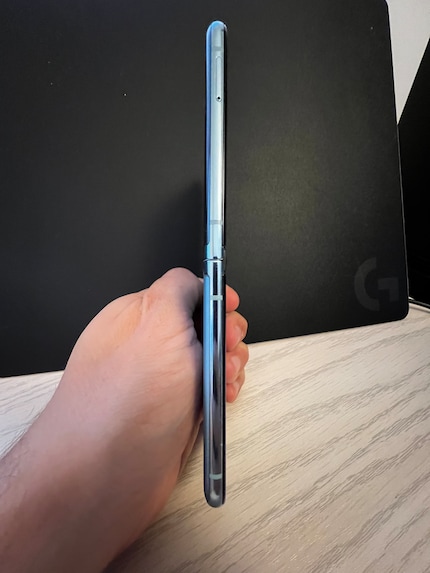
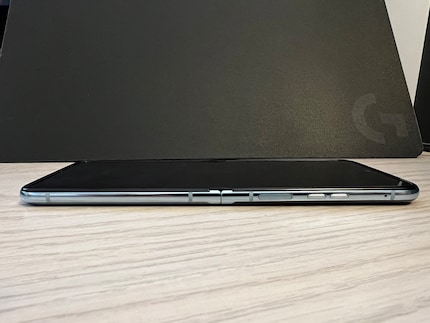
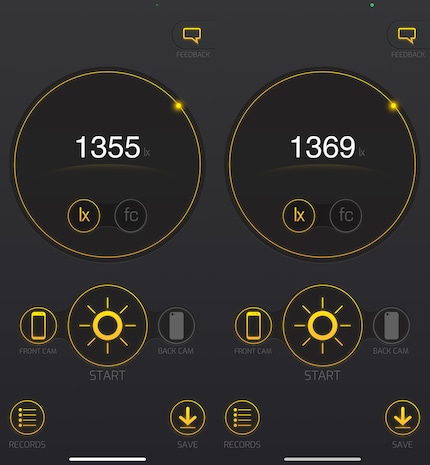
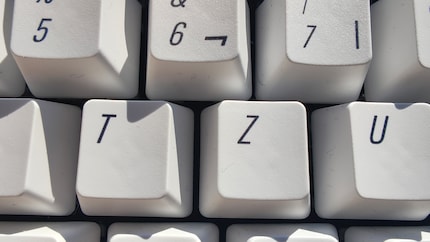
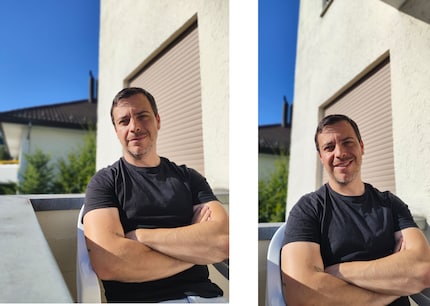

In my case, an average day means some surfing, two hours of streaming on Spotify, about 20 WhatsApp messages, half a dozen snapshots with the camera and two phone calls lasting around 10 minutes each. This equates to around four to five hours of screen time. I first unplugged the phone at 6.30 a.m., and the 20 per cent warning appeared at 7 p.m. However, the remaining charge held up well until I went to bed. Charging once a day is enough if you don’t have a conference call or an orienteering session with Google Maps planned.